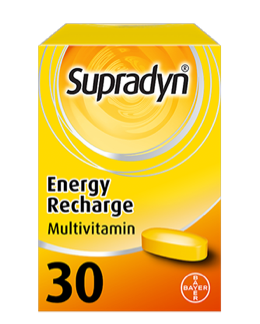RECHARGE MAGAZINE
How to recharge after flu
The modern way of life doesn’t allow people to get sick. The busy lifestyles, juggling family, work and social duties don’t leave much time for staying in bed. Additionally, daily stress can weaken your immune system. Respiratory tract infections, such as the flu and cold, are among the most common diseases in humans. They are seasonal and are caused by large number of viruses. On average, adults get sick two to five times a year and children even more often.1
Flu is a very contagious disease and can knock you off your feet for days or even weeks. Although normally it doesn’t cause complications, there is a chance it can lead to more serious health problems like sinus infections, bronchitis or pneumonia.
Flu can leave you feeling drained and tired. This fatigue is caused by the fact that your body is using all its energy to fight the viruses. On top of that you probably don’t provide your body with enough nutrients because you don’t feel like eating. After spending several days in bed you probably can’t wait to get back to your normal routine. However, resuming your schedule too quickly and intensely can only prolong your recovery or even put you back in bed.
So how can you rebuild your body and bounce back after being sick?
There are some things to avoid if you wish to get back on your feet quickly:
- Don’t exercise too hard. Excessive training can put too much stress on your body. If you used to run every day, start with walking first.
- Don’t drink alcohol. It drains your body of vitamin C and other nutrients that your body craves after fighting the viruses.10
- Don’t smoke. Smokers are more prone to infections. Nicotine intake impairs the ability of white blood cells to kill pathogens.11,12 Smokers also have fewer good bacteria in the body, and more bacteria that cause skin and oral diseases.13
There is no better remedy to fight off the flu than sleep. It not only speeds up recovery but also reduces the risk of serious flu complications. Try to relax at least two hours before going to bed and try to add about an hour to your normal sleep pattern for at least a fortnight. You can also consider adding Supradyn difese to your diet. One orange-flavored tablet a day strengthens your natural defenses and lets you say goodbye to cold and flu.
1 Rondanelli, M., Miccono, A., Lamburghini, S., Avanzato, I., Riva, A., Allegrini, P., … Perna, S. (2018). Self-Care for Common Colds: The Pivotal Role of Vitamin D, Vitamin C, Zinc, and Echinacea in Three Main Immune Interactive Clusters (Physical Barriers, Innate and Adaptive Immunity) Involved during an Episode of Common Colds—Practical Advice on Dosages and on the Time to Take These Nutrients/Botanicals in order to Prevent or Treat Common Colds. Evidence-Based Complementary and Alternative Medicine, 2018, 1–36. doi: 10.1155/2018/5813095
2 Lissiman, E., Bhasale, A. L., & Cohen, M. (2014). Garlic for the common cold. Cochrane Database of Systematic Reviews. doi: 10.1002/14651858.cd006206.pub4
3 King, S., Glanville, J., Sanders, M. E., Fitzgerald, A., & Varley, D. (2014). Effectiveness of probiotics on the duration of illness in healthy children and adults who develop common acute respiratory infectious conditions: a systematic review and meta-analysis. British Journal of Nutrition, 112(1), 41–54. doi: 10.1017/s0007114514000075
4 Rop, O., Mlcek, J., Jurikova, T. (2009). Beta-glucans in higher fungi and their health effects. Nutrition Reviews, 67(11), 624-631. Doi: 10.1111/j17534887200900239.x
5 Hemilä, H. (2017). Vitamin C and Infections. Nutrients, 9(4), 339. doi: 10.3390/nu9040339
6 D’Souza, S. P., Chavannavar, S. V., Kanchanashri, B., & Niveditha, S. B. (2017). Pharmaceutical Perspectives of Spices and Condiments as Alternative Antimicrobial Remedy. Journal of Evidence-Based Complementary & Alternative Medicine, 22(4), 1002–1010. doi: 10.1177/2156587217703214
7 Sanu, A., Eccles, R. (2008). The effects of a hot drink on nasal airflow and symptoms of common cold and flu. Rhinology, 46(4), 271-275.
8 Higdon, JV., Frei, B. (2003). Tea catechins and polyphenols: health effects, metabolism, and antioxidant functions. Critical Reviews in Food Science and Nutrition, 43(1), 89-143.
9 Meltzer, E. (2010). Treatment of congestion in upper respiratory diseases. International Journal of General Medicine, 69. doi: 10.2147/ijgm.s8184
*10 Faizallah, R., Morris, A. I., Krasner, N., & Walker, R. J. (1986). Alcohol Enhances Vitamin C Excretion In The Urine. Alcohol and Alcoholism, 21(1), 81–84. doi: 10.1093/oxfordjournals.alcalc.a044595
11 Guo, S., & Dipietro, L. (2010). Factors Affecting Wound Healing. Journal of Dental Research, 89(3), 219–229. doi: 10.1177/0022034509359125
12 McDaniel, J. C., & Browning, K. K. (2014). Smoking, Chronic Wound Healing, and Implications for Evidence-Based Practice. Journal of Wound, Ostomy and Continence Nursing, 41(5), 415–423. doi: 10.1097/won.0000000000000057
13 Kumar, P. S., Matthews, C. R., Joshi, V., Jager, M. D., & Aspiras, M. (2011). Tobacco Smoking Affects Bacterial Acquisition and Colonization in Oral Biofilms. Infection and Immunity, 79(11), 4730–4738. doi: 10.1128/iai.05371-11














